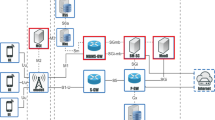Abstract
In order to meet the growing demand for mobile multimedia broadcast services 3GPP includes evolved multimedia broadcast and multicast (eMBMS) services in LTE systems. The high data rates, low latency and QoS provisioning makes LTE systems more suitable for mobile broadcast and multicast services than legacy wireless networks. However, the 3GPP standards has not specified any scheduling strategy for this broadcast and multicast services. In this paper, we propose a novel eMBMS scheduling technique (NEST) which focuses on reducing the average waiting time (latency) of the broadcast services offered by LTE system. This paper has twofold contributions. We proffer NEST considering two types of impatience that is user equipment (UE) departure and UE request repetition. Our proposed scheduling strategy estimates the effects originating from the departure of the mobile UEs and UE request repetition case. It intelligently combines the advantages of both flat scheduling and on-demand scheduling in such a way that the overall latency of the system is reduced. We design a suitable modeling framework to analyze the performance of the system. Simulation experiments on typical LTE systems support the performance analysis and demonstrates 10 % gains while comparing with existing eMBMS scheduling available in present LTE systems.














Similar content being viewed by others
References
Evolved universal terrestrial radio access (E-UTRA) and evolved universal terrestrial radio access network (E-UTRAN): Overall description; Stage 2. In 3GPP TS 36.300.
Multimedia broadcast/multicast service (MBMS); protocols and codecs. In 3GPP TS 26.346.
Improvement of the multimedia broadcast multicast service (MBMS) in UTRAN. In 3GPP TR 25.905.
Evolved universal terrestrial radio access (E-UTRA); LTE physical layer; General description. In 3GPP TS 36.201.
Dahlman, E., Parkvall, S., & Skold, J. (2013). 4G: LTE/LTE-advanced for mobile broadband. London: Academic press.
Gross, D., & Harris, C. M. (2008). Fundamentals of queuing theory. London: Wiley.
LTE; evolved universal terrestrial radio access (E-UTRA); radio resource control (RRC); protocol specification. In 3GPP TS 36.331.
Lescuyer, P., & Lucidarme, T. (2008). Evolved packet system (EPS)—The LTE and SAE evolution of 3G UMTS. London: Wiley.
Saxena, N., & Roy, A. (2008). Data scheduling and transmission strategies in asymmetric telecommunication environments. London: CRC Press.
Nonchev, S., & Valkama, M. (2009). A new fairness oriented packet scheduling scheme with reduced channel feedback for OFDMA packet radio systems. International Journal of Communications, Networks and Systems Sciences, 2(7), 608–618.
Ramli, H. A. M., Basukala, R., Sandrasegaran, K., & Patachaianand, R. (2009). Performance of well known packet scheduling algorithms in the downlink 3GPP LTE systems. In IEEE MICC, Kuala Lumpur (pp. 815–820).
Iosif, O., & Banica, I. (2011). On the analysis of packet scheduling in downlink 3GPP LTE system. In The fourth international conference on communication theory, reliability and quality of service, Budapast, Hungary (pp. 99–102).
Lecompte, D., & Gabin, F. (2012). Evolved multimedia broadcast/multicast service (eMBMS) in LTE-advanced: Overview and Rel-11 enhancements. IEEE Communications Magazine, 50(11), 68–74.
Rahman, M. M., Hsu C.-H., Hasib, A., & Hefeeda, M. (2014). Hybrid multicast-unicast streaming over mobile networks. In Networking conference, IFIP, Trondhein (pp. 1–9).
Fuente, A. de la, Garcia Armada, A., & Leal, R. P. (2014). Joint multicast/unicast scheduling with dynamic optimization for LTE multicast service. In European wireless conference, Barcelona, Spain (pp. 1–6).
Araniti, G., Condoluci, M., Militano, L., & Iera, A. (2013). Adaptive resource allocation to multicast services in LTE systems. IEEE Transactions on Broadcasting, 59(4), 658–664.
Tassi, A., Khirallah, C., Vukobratovi, D., Chiti, F., Thompson, J., & Romano F. (2013). Reliable rate-optimized video multicasting services over LTE/LTE-A. In ICC, Budapast, Hungary (pp. 5078–5082).
Condoluci, M., Araniti, G., Molinaro, A., & Lera, A. (2013). Exploiting frequency-selectivity in real-time multicast services over LTE networks. In PIMRC, London, UK (pp. 1794–1798).
Acharya, S., & Muthukrishnan, S. (1998). Scheduling on-demand broadcasts: New metrics and algorithms. In MobiCom, Dallas, TX (pp. 43–54).
Brandwain, A. (1979). An iterative solution of two-dimensional birth and death processes. Operations Research, 27(3), 595–605.
OPNET Modeler and LTE modeling. In OPNET. http://www.opnet.com.
Jiang, S., & Vaidya, N. H. (1999). Scheduling data broadcast to ’impatient’ users”. In ACM international workshop on mobile data engineering, Seattle, USA (pp. 52–59).
Sachan, R., Saxena, N., & Roy, A. (2013). An efficient hybrid scheduling scheme for impatience user in embms over LTE. In International Conference on Computer communication and informatics (ICCCI), India (pp. 1–5).
Karimi, O. B., & Liu, J. (2011). Power efficient high quality multimedia multicast in LTE wireless networks. In IEEE 8th international conference on mobile adhoc and sensor systems (MASS), Valencia (pp. 161–163).
Acknowledgments
This research was supported by Basic Science Research Program through the National Research Foundation of Korea (NRF) funded by the ministry of Education (S-2015-0849-000).
Author information
Authors and Affiliations
Corresponding author
Rights and permissions
About this article
Cite this article
Saxena, N., Singh, S., Roy, A. et al. NEST: novel eMBMS scheduling technique. Wireless Netw 22, 1837–1850 (2016). https://doi.org/10.1007/s11276-015-1067-0
Published:
Issue Date:
DOI: https://doi.org/10.1007/s11276-015-1067-0




